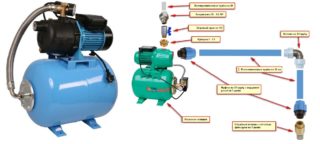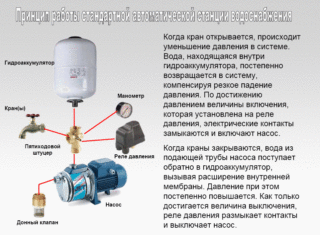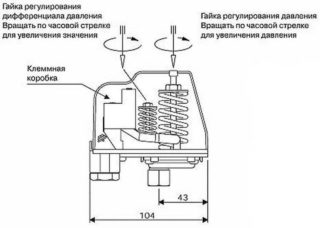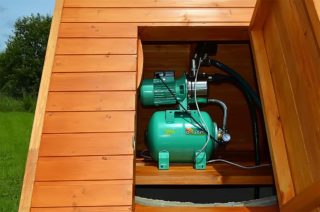A pumping station in your home is a guarantee of a comfortable life. After spending a little time on its installation and maintenance, you can relax or do useful things, because you no longer have to carry water in buckets. The pump will pump water from a well or well into a storage tank, will help the central water supply by increasing the pressure. It will turn on itself at the right time and turn off when the pressure in the water supply system reaches the norm. However, any equipment requires proper operation, so you need to know exactly how to properly start or maintain a pumping station to supply water at any time of the year.
Features and algorithm of actions when starting a pumping station

Installation, grounding and start-up of the pumping station must be carried out by a specialist who has permission and qualifications to carry out these works. If this condition is met, there will be no reason to refuse warranty repair in the event of a pump breakdown. However, a competent and skilled man can independently connect the station by reading the instructions and observing safety measures.
The pumping station is installed in an insulated room and is protected from the effects of negative temperatures or flooding. Given the noise of the unit, it is necessary to place it at a distance from living rooms or provide a soundproof casing, which, by the way, can simultaneously serve as a heater. The station should be rigidly anchored to a concrete base or steel frame. Power supply required 220 V.
The pumping station has 1 class of protection, therefore, before connecting to the network to ensure electrical safety, it must be grounded (zeroed).
Before starting a new pumping station for the first time, it is necessary to check the air pressure in the accumulator. It should be in the range of 1.4-1.7 atm. for small containers up to 25 l; 1.7-1.9 atm. for larger ones. For measurements, an auto-pump with a pressure gauge is used; it can also pump air through the valve if necessary.

- Place the station on a firm, level surface, fasten it.
- Check the accumulator. When the tank is empty, the standard pressure is 1.5 atm., If it is more, it is necessary to bleed air through the nipple, less - to pump it up.
- At the initial suction point, install a check valve with a coarse filter mesh on the pipe, lower it into the water intake. The angle of inclination of the suction line from the pump to the source of 10 degrees or more to the horizon must be observed. For suction, rigid metal or HDPE pipes are used, as well as reinforced hoses with a diameter of 25-32 mm.
- Connect the suction line to the inlet on the body.
- Connect the pressure line via the connecting nipple.
- Fill the pump and suction pipe with water: open the filling hole on the body, closed with a plug or valve; pour until the liquid begins to flow back; close tightly.
- Connect the power cable to a grounded outlet, press "start".
- Open the nearest tap to bleed the remaining air from the water supply.
- After 3-5 minutes of pump operation, water should flow from the tap. If this does not happen: turn off the station, re-fill with water, start again.
Duty cycle: the pump builds up a pressure of 3-4 atm. and turns off, turns on only after opening the taps in the house in order to normalize the pressure in the system again.
It is forbidden to use the pumping station for pumping aggressive chemical or flammable liquids.

Upon successful start of the pumping station, set up the automation.
- Disconnect the station from the mains, drain the water, open the pressure switch, there are large and small adjusting springs.
- Turn on the pump to start collecting liquid in the tank. When the pressure rises and the pump turns off, the pressure gauge will show the upper pressure, write it down.
- To reduce the pressure in the system, open the furthest tap or the one on the topmost floor. After a while, the relay will connect the pump - the lower pressure will be reflected on the pressure gauge, write it down.
Compare the reading with the reference. The standard shutdown pressure is 3 atmospheres or 2.8 bar, the switching-on pressure is 1.5 atm. or 1.4 bar, the interval between the boundaries should be 1.5 atm. (1.4 bar).
If the indicators of the pumping station do not differ from the norm, do not change anything.
If the pressure difference is less than the norm, to increase it, with the pump turned off, slightly tighten the nut on the small spring, to reduce the difference, loosen it.
Too high pressure in the tank will cause frequent switching on / off. The underestimated pressure will force the pump to work without stopping. Any option will cause rapid equipment wear
During the test, you can also adjust the pressure. A weak pressure in the system leads to the fact that water from the tap flows out without enthusiasm - this is uncomfortable for users. To strengthen it, with the station turned off, slightly tighten the nut on the large spring of the relay, to reduce the pressure, loosen it.
You should not immediately change the factory settings of the accumulator up or down on your own. The new unit must work for several days in order to reveal all the existing shortcomings.
So that the water supply does not stop at any time of the year, the water conduit and the pumping station should be protected from negative temperatures, since the freezing of water in the system can completely damage the equipment. Such damage is not subject to warranty repair. Therefore, cold water pipes are laid in trenches at a depth below the freezing point of the soil by 0.5 m or equipped with an electric cable for heating. The pumping station itself is installed in heated rooms, insulated basements or sheds, as well as caissons or chambers located 2 m below ground level.
When using the water supply system seasonally, only in the warm season, it is necessary to completely drain the water from the pumping station and the water supply before the onset of frost
After a long conservation of the water supply system, if the house is empty, with the end of the summer cottage, the system is airing. Before restarting the pumping station after a downtime or cold winter, preparatory work should be carried out to clean the equipment and displace air.
- Clean the check valve mesh filter located on the horizontal section of the suction pipe in the water intake. During the downtime of the water supply system, it could be clogged with debris or silted up.
- Check the performance of the suction line. To do this, you need to spill water through it from the point of entry into the pumping station to the point of exit into the water intake. Remember to remove the filter check valve. If there is a problem: an ice plug formed, the pipe flattened, cracks appeared or the joints were depressurized, everything must be eliminated before connecting, otherwise the pump will not be able to lift water from the well or well.
- Fill the pump and suction hose through the filler hole or valve. Finish pouring only after the water overflows and settles in the neck at a constant level. Close the hole.
- Check the air pressure in the accumulator. If necessary, increase it to the standard by pumping it through the valve.
After carrying out all the procedures, you can safely start the pumping station.
Common mistakes when starting the station and how to avoid them

When starting a pumping station, problems can arise for various reasons. The most common of these are engine or pump malfunctions, for example:
- The engine will not start. Check if it is plugged in. Check fuses, replace if necessary. If the fan impeller does not turn, disconnect the motor from the mains and turn it with a screwdriver.
- The engine is running, but the water is not pumping. The pump may not have been filled with water at startup. It is necessary to turn off the engine and fill with water.
- The unit works without shutting down. The relay may be set to a higher upper pressure. It needs to be adjusted.
- The pump turns on and off more than 20 times per hour. Probable cause: the pressure in the accumulator is low, for example, due to a damaged membrane. It is necessary to replace the part and pump up the pressure to normal.
Sometimes problems are easier to prevent than fix. If the station is not mothballed in the fall and stored in an unheated room in winter, the remnants of non-drained water during freezing can damage important parts of the mechanism or the water conduit; in the spring you will have to buy a new station or carry out expensive repairs. Therefore, compliance with the operating rules will extend the life of the equipment and significantly reduce costs.








